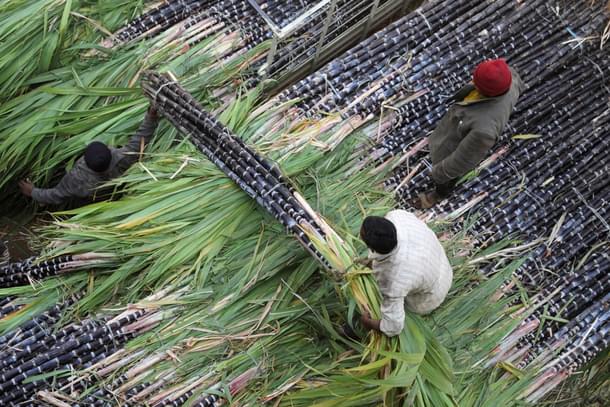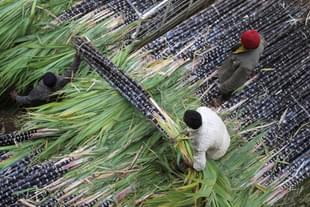Business
Explained: Pros And Cons Of NITI Aayog Recommendation To Lower Sugarcane Production
M R Subramani
Aug 17, 2020, 03:07 PM | Updated 03:07 PM IST
Save & read from anywhere!
Bookmark stories for easy access on any device or the Swarajya app.


The NITI Aayog, the Union government’s think-tank, has suggested that the country should cut the area under sugarcane and farmers could be given an incentive of Rs 6,000 per acre to shift to other crops.
The NITI Aayog’s task force on agriculture has made this recommendation among others. It has mooted that the area under sugarcane be brought down by three lakh hectares (lh) from the current area ranging between 45 lh and 50 lh.
This is not much but the think-tank has also suggested that sugar mills buy only 85 per cent of the sugarcane produced by a grower so that they will be discouraged from bringing more cane to the mills for crushing.
The task force has also asked the Centre to scrap the buffer stocks created by the Centre to stabilise falling sugar prices. For the August 2019-July 2020 period, the Union government set up four million tonnes (mt) sugar buffer stocks.
Payment for the buffer stocks were made by the Centre directly to farmers' bank accounts against the dues the latter were owed by sugar mills.
The NITI-Aayog said that the stocks led to a rise in sugar prices even as the Centre had to bear their carrying, storage and insurance costs.
The think tank’s recommendations come at a time when the buffer stock scheme has ended and no decision has yet been taken on it. The sugar industry has been demanding the extension of the scheme.
The development also comes ahead of projections that the country could have a carry over of 11.2 mt sugar stocks when the new sugar season begins in October this year.
There are pros and cons of the suggestion to bring down the area under sugarcane. One of the pros of the decision is that the Centre can now be expected to scale down its support to the sugar industry.
The industry is currently battling surplus production, and it has been one of the sectors that has drawn the Centre’s support, irrespective of the party in power.
In 2018, the Centre allocated Rs 5,500 crore to inject liquidity in the sector. Last year, the Centre gave a Rs 6,268 crore subsidy for export of 6 mt of sugar.
The question among economists is that why should the sugar industry be meted out special treatment that costs crores of rupees of the taxpayers' money.
Last year, speaking at the Sugar Conclave in Pune, Union Transport Minister Nitin Gadkari ruled out any more help to the sugar sector, saying the government has tried to help it as much as possible.
Cutting down sugarcane production means saving precious water. In particular, farmers in Maharashtra, which often faces water scarcity, use trillions of litres of water to cultivate sugarcane. Should a water guzzling crop continue to be promoted when it leads to surplus production and eats into taxpayers money?
According to the Commission for Agricultural Costs and Prices (CACP), it takes over 2,500 litres of water to produce a kg of sugar.
In Maharashtra, sugarcane accounts for only 4 per cent of the total cropped area but it consumes 70 per cent of the water used for irrigation in the state.
Also, the cane yield is low, with the obsolete technology of sugar mills also affecting recovery from the cane to produce sugar.
Cutting production will force the growers and industry to go in for higher yield, better varieties and latest technologies.
In fact, such a move will help sugarcane growers as they currently fetch 1.18 times return on their investment if the cane is planted. In case of ratoon crop, which is actually cutting the stem and leaving the root part intact, the growers fetch a return of 2.8 times their investment.
The CACP has said that the average net return for sugarcane growers is 10 times the realisation of cotton and gram put together. Therefore, going in for high yielding varieties and better technology will help growers get higher returns.
However, the industry sees the move as unwise. There is no doubt that the sugar sector is one that faces quite a few restrictions such as allocation of sugarcane area, payment to be made to growers especially as per prices fixed by the state governments, and stock release orders.
The Mumbai Mirror quoted Prakash Naiknavare, National Federation of Cooperative Sugar Factories managing director, as saying that farmers need to be given double protection by any crop that the sugarcane crop currently provides them.
The sugarcane grower is ensured of a fair and remunerative price fixed by the Union government, while the marketing of his production is ensured by sugar factories buying it. No other crop provides such a cushion.
The question is what crop will the farmer be encouraged to grow in the place of sugarcane and will its return be as remunerative as the sugarcane?
The NITI Aayog recommends Rs 6,000 per acre payment but for how long will it be given to the grower?
Also, how will the Centre face pressure from Maharashtra, where nearly half of the ministers own or control private and cooperative sugar factories in their districts?
The government can, however, look back at the success of helping tobacco farmers choosing an alternative crop. In Uttar Pradesh, the area under tobacco has come down around 20,000 hectares now from 1.15 lakh hectares during 2000-01.
In the case of Uttar Pradesh, the farmers were encouraged to take up cash crops such as mustard, cotton, cauliflower, maize and other vegetables. Today, they are reporting better income than what they got while cultivating tobacco.
Experts say that one way of helping sugarcane growers would be to divert more cane towards ethanol production. In fact, Gadkari has been a proponent of this.
Currently, the Centre has mandated 10 per cent ethanol blending with petrol. However, the sugar industry’s ethanol supply is meeting only 8.5 per cent of blending demand. Thus, the 1.5 percentage supply gap in ethanol blending has to be met, and which can be done easily.
According to Balrampur Chini, it realised Rs 41.68 per litre for supplying ethanol to oil marketing companies in 2018-19 compared with Rs 39.46 per litre the previous fiscal.
The Centre is looking to raise ethanol blending to 20 per cent by 2030 once the sugar industry meets the 10 per cent target. But that will come only after it first meets the 15 per cent target.
Sugar millers will also have to look at options such as co-generation of power, molasses and bagasse to make optimum use of their investment. All these can, probably, help growers and mills get better returns.
M.R. Subramani is Executive Editor, Swarajya. He tweets @mrsubramani





